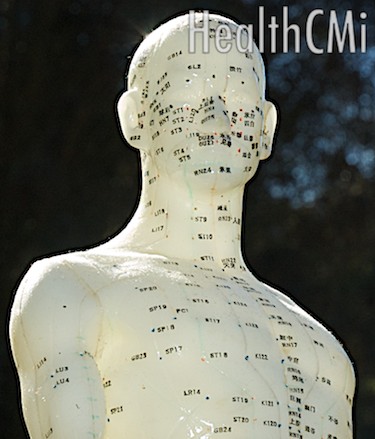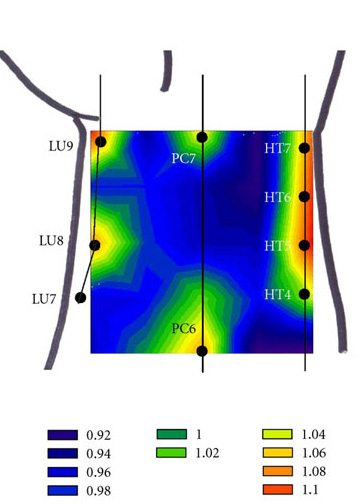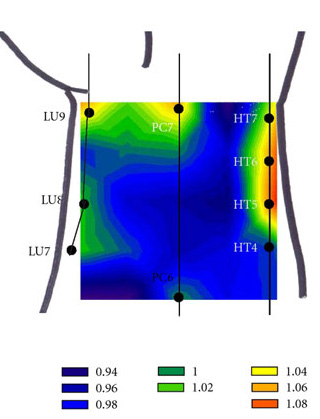X-ray images of acupuncture points show that unique structures exist.  This and other incredible acupuncture research marks the start of the Year of the Horse. Additionally, new research confirms that acupuncture is effective for the treatment of depression, anxiety and hypertension. Moreover, the anti-inflammatory effects of acupuncture can avert sepsis and save lives. Let’s take a look at these discoveries.
This and other incredible acupuncture research marks the start of the Year of the Horse. Additionally, new research confirms that acupuncture is effective for the treatment of depression, anxiety and hypertension. Moreover, the anti-inflammatory effects of acupuncture can avert sepsis and save lives. Let’s take a look at these discoveries.
Scholars were amazed at the new CT (computerized tomography) scans of acupuncture points. The CT X-rays, published in the Journal of Electron Spectroscopy and Related Phenomena, reveal clear distinctions between non-acupuncture point and acupuncture point anatomical structures. New in-line phase contrast synchrotron radiation CT techniques reveal that acupuncture points have a uniquely high density of micro-vessels and contain a large amount of involuted microvascular structures that are not present in non-acupuncture points.
Acupuncture points have microvascular densities with bifurcations that “can be clearly seen around thick blood vessels” but non-acupuncture points show few thick blood vessels and none show fine, high density structures found in true acupuncture points. The researchers note that “the high brightness, wide spectrum, high collimation, polarization and pulsed structure of synchrotron radiation” facilitated the discovery. The research team concluded, “Our results demonstrated again the existence of acupoints, and also show that the acupoints are special points in mammals.”
These findings emerged at a time when the academic community had recently learned that acupuncture points have higher oxygen pressure levels. Using an amperometric oxygen microsensor to detect partial oxygen pressure variations at different locations on the anterior aspect of the wrist, researchers discovered something astonishing. Acupuncture points have measurable and unique oxygen characteristics. This evidence is scientifically repeatable and the oxygen sensor imaging exactly corresponds to all acupuncture points in the region: LU9, LU8, LU7, PC7, PC6, HT7, HT6, HT5 and HT4. Non-acupuncture points do not demonstrate these qualities. Additional acupuncture continuing education research reveals important clinical findings. The following images are the oxygen sensor images with a grid overlay of acupuncture point locations for reference.


Acupuncture is Anti-Inflammatory
Researchers at the Department of Surgery, Rutgers New Jersey Medical School have discovered that electroacupuncture fights infections including polymicrobial peritonitis. In a laboratory experiment, the researchers proved that electroacupuncture reduces severe systemic inflammation due to infections, sepsis. The researchers discovered that the anti-inflammatory effects of electroacupuncture “are voltage dependent.” Non-acupuncture points (sham points) did not exert anti-inflammatory responses. Only true acupuncture was effective in regulating cytokine levels, preventing sepsis and boosting dopamine levels. The anti-inflammatory mechanism of electroacupuncture is now proven to be “mediated by the sciatic and vagus nerves that modulates the production of catecholamines in the adrenal glands.” The Rutgers New Jersey Medical School researchers added that there is ”growing evidence supporting its effects in postoperative and stroke rehabilitation.”
Acupuncture Prevents Stroke
New recent demonstrates that acupuncture significantly decreases the risk of stroke for patients with traumatic brain injuries (TBIs). In a large scale study of 29,636 patients, researchers document that TBI patients receiving acupuncture have a “lower probability of stroke than those without acupuncture treatment during the follow-up period.”
Acupuncture For Depression & Anxiety
The success of acupuncture for the treatment of depression and anxiety has been demonstrated in recent studies. Chuhua et al. conclude that acupuncture is effective for the treatment of generalized anxiety disorder (GAD) and that “a number of Meta analysis and system evaluations point out that acupuncture treatment has more advantages than drugs in the treatment of anxiety disorders….”
Acupuncture Benefits The Brain
Yang et al. note that numerous studies demonstrate “that acupuncture is an effective remedy for depression and it may be as effective as antidepressant drugs.” They conducted a lab experiment and discovered that electroacupuncture increases neurogenesis in the hippocampus in the same manner as SSRI antidepressants. Neurogenesis is the process by which neurons are generated from neural stem and progenitor cells. Electroacupuncture “alleviated depressive-like and anxiety-like behaviors in the rat” group, restored proliferation of ANPs (amplifying neural progenitors) and limited cell death of QNPs (quiescent neural progenitors). This caused a preservation of NPs (neural progenitor cells) in the hippocampus, an important part of the brain’s limbic system.
Acupuncture Lowers Blood Pressure
There is no shortage of hard data demonstrating that acupuncture can reduce hypertension. The research of Shaoyang Cui et al. concludes that acupuncture has a “stable antihypertensive effect.” They add, “Many animal and clinical studies have reported the efficacy of acupuncture in reducing hypertension.” This study isolated the effects of a single acupuncture point on laboratory rats with hypertension. The researchers conclude acupuncture at KI3 has an “antihypertensive effect for essential hypertension.”
Researchers at the University of California, Irvine and University of California, Los Angeles concur that acupuncture is effective in lowering blood pressure. Their study investigated the effectiveness acupuncture points P5, P6, LI10 and LI11 combined with electroacupuncture for the treatment of hypertension. The researchers concluded that acupuncture successfully reduces hypertension. The researchers discovered an additional finding; the application of this acupuncture treatment prescription protocol protected heart tissues and reduced arrhythmias.
About the Healthcare Medicine Institute (HealthCMi):
HealthCMi publishes acupuncture CEU and acupuncture PDA courses online for state and national NCCAOM acupuncture continuing education credit. The HealthCMi news division reports on up-to-date medical research.
References:
Chenglin, Liu, Wang Xiaohu, Xu Hua, Liu Fang, Dang Ruishan, Zhang Dongming, Zhang Xinyi, Xie Honglan, and Xiao Tiqiao. "X-ray phase-contrast CT imaging of the acupoints based on synchrotron radiation." Journal of Electron Spectroscopy and Related Phenomena (2013).
Minyoung Hong, Sarah S. Park, Yejin Ha, et al., “Heterogeneity of Skin Surface Oxygen Level of Wrist in Relation to Acupuncture Point,” Evidence-Based Complementary and Alternative Medicine, vol. 2012, Article ID 106762, 7 pages, 2012. doi:10.1155/2012/10a6762.
Observation on the mechanism of acupuncture treatment for generalized anxiety disorder using Lieque (LU7), Zhaohai (KI6) as the main acupoints. Lin, Chuhua; Zhao, Xiaoyan; Liu, Xing; Fu, Wenbin. Bioinformatics and Biomedicine (BIBM), 2013 IEEE International Conference on. 18-21, 12-2-13.
Rafael Torres-Rosas, Ghassan Yehia, Geber Peña, Priya Mishra, Maria del Rocio Thompson-Bonilla, Mario Adán Moreno-Eutimio, Lourdes Andrea Arriaga-Pizano, Armando Isibasi, Luis Ulloa. Dopamine mediates vagal modulation of the immune system by electroacupuncture. Nature Medicine, 2014; DOI: 10.1038/nm.3479.
Shih, Chun-Chuan, Yi-Ting Hsu, Hwang-Huei Wang, Ta-Liang Chen, Chin-Chuan Tsai, Hsin-Long Lane, Chun-Chieh Yeh et al. "Decreased Risk of Stroke in Patients with Traumatic Brain Injury Receiving Acupuncture Treatment: A Population-Based Retrospective Cohort Study." PLOS ONE 9, no. 2 (2014): e89208.
Observation on the mechanism of acupuncture treatment for generalized anxiety disorder using Lieque (LU7), Zhaohai (KI6) as the main acupoints. Lin, Chuhua; Zhao, Xiaoyan; Liu, Xing; Fu, Wenbin. Bioinformatics and Biomedicine (BIBM), 2013 IEEE International Conference on. 18-21, 12-2-13.
Yang, Liu, Na Yue, Xiaocang Zhua, Qiuqin Hana, Bin Lia, Qiong Liu, Gencheng Wu, and Jin Yu. "Electroacupuncture promotes proliferation of amplifying neural progenitors and preserves quiescent neural progenitors from apoptosis to alleviate depressive-like and anxiety-like behaviours.”
Antihypertensive Effect of Acupuncturing at KI3 in Spontaneously Hypertensive Rats, Shaoyang CUI, Mingzhu Xu, Shuhui Wang, Chunzhi Tang, Xinsheng Lai, Zhiqi Fan; Shenzhen Futian Hospital of TCM, Guangzhou University of Chinese Medicine; 2013 IEEE International Conference on Bioinformatics and Biomedicine.
Zhang, Lili, Pengfei Shen, and Shu Wang. "Acupuncture treatment for hypertension: a case study." Acupuncture in Medicine (2013): acupmed-2013.
Cevik, C., and S. O. Işeri. "The effect of acupuncture on high blood pressure of patients using antihypertensive drugs." Acupuncture & electro-therapeutics research 38, no. 1-2 (2012): 1-15.
Severcan, C., C. Cevik, H. V. Acar, A. B. Sivri, S. S. Mit, E. Geçioğlu, O. T. Paşaoğlu, and Y. Gündüztepe. "The effects of acupuncture on the levels of blood pressure and nitric oxide in hypertensive patients." Acupuncture & electro-therapeutics research 37, no. 4 (2012): 263.
Evidence-Based Complementary and Alternative Medicine. Volume 2012 (2012), Article ID 878673, 9 pages. doi:10.1155/2012/878673. Neuroendocrine Mechanisms of Acupuncture in the Treatment of Hypertension. Wei Zhou and John C. Longhurst. Department of Anesthesiology, David Geffen School of Medicine, University of California, Los Angeles. Department of Medicine, University of California, Irvine.


